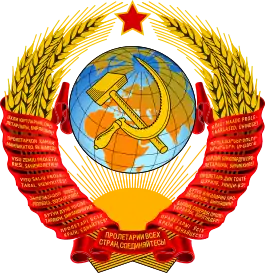Soviet annexation of Western Belorussia
On the basis of a secret clause of the Molotov–Ribbentrop Pact, the Soviet Union invaded Poland on September 17, 1939, capturing the eastern provinces of the Second Polish Republic. The eastern provinces of interwar Poland were inhabited by an ethnically mixed population, with ethnic Poles as well as Polish Jews dominant in the cities. These lands now form the backbone of modern Western Ukraine and Western Belarus.[1][2]
The annexation of the Polish territories, which were added to Soviet Byelorussia, and the Ukrainian Soviet Socialist Republic alone, resulted in the Soviet state gaining 131,000 square kilometres (50,600 sq mi), and increasing its population by over seven million people.
Annexation of eastern half of interwar Poland
On September 17, 1939 the Red Army entered Polish territory, acting on the basis of a secret clause of the Molotov–Ribbentrop Pact between the Soviet Union and Nazi Germany. Soviet Union would later deny the existence of this secret protocol, claiming that it was never allied with the German Reich, and acted independently to "protect" the Ukrainian and Belarusian minorities in the disintegrating Polish state.[3]
Support demonstrations were staged by pro-Soviet militias.[4] Immediately after entering Poland's territory, the Soviet army helped to set up "provisional administrations" in the cities and "peasant committees" in the villages in order to organize one-list elections to the new "People's Assembly of Western Belarus". The elections were designed to give the annexation an appearance of validity, but were far from free or fair. The voters had a choice of only one candidate, often a local communist or someone sent to western Belarus from Soviet Belarus for each position of deputy; the communist party commissars then provided the assembly with resolutions that would push through nationalization of banks and heavy industry and transfers of land to peasant communities.[5] Elections took place on October 22, 1939; the official numbers reported participation of 93 percent of the electorate, 91 percent of whom supported the appointed candidates. Based on these results, the People's Assembly of Western Belarus voted unanimously to thank Stalin for liberation and sent a delegation to Moscow to ask for formal inclusion of the territories into the Belarusian SSR. The Supreme Soviet voted to do so on November 1, 1939 and on November 15 a law was passed making the former eastern Polish territories a part of the Belarusian SSR.
On October 30, the People's Assembly of Western Belarus session held in Belastok (Polish Białystok) affirmed the Soviet decision to join the Belarusian Soviet Socialist Republic (BSSR) with the USSR. The petition was officially accepted by the Supreme Soviet of the USSR on November 2 and by the Supreme Soviet of the BSSR on November 12, 1939.[6] From then on, all citizens of Poland but also born in Poland would find themselves living in the Byelorussian SSR as the Soviet subjects, without the recognition of their Polish citizenship.[2]
The Soviet invasion of Poland was portrayed by the Soviet propaganda as the "liberation of Western Belorussia and Ukraine". Many ethnic Belarusians welcomed unification with the BSSR. They changed their attitude after experiencing firsthand the terror of the Soviet system.[2][7]
Deportations, arrests, and the reign of terror
The Soviets quickly began confiscating, nationalizing, and redistributing all private and state-owned Polish property.[8] During the two years following the annexation, the Soviets arrested approximately 100,000 Polish citizens across Kresy.[9] Due to a lack of access to the secret Soviet and Belorussian archives, for many years after the war the estimates of the number of Polish citizens deported to Siberia from the areas of Western Belorussia, as well as the number who perished under Soviet rule, were only estimated.[10] In August 2009, on the occasion of the 70th anniversary of the Soviet invasion, the authoritative Polish Institute of National Remembrance announced that its researchers reduced the estimate of the number of people deported to Siberia to 320,000 in total. Some 150,000 Polish citizens perished under the Soviet rule.[11]
References
- Alice Teichova, Herbert Matis, Jaroslav Pátek (2000). Economic Change and the National Question in Twentieth-century Europe. Cambridge University Press. pp. 342–344. ISBN 978-0-521-63037-5.CS1 maint: multiple names: authors list (link)
- Norman Davies, God's Playground (Polish edition), second tome, p.512-513.
- Anna M. Cienciala (2004). The Coming of the War and Eastern Europe in World War II (lecture notes, University of Kansas). Retrieved 15 March 2006.
- (in Polish) Marek Wierzbicki, Stosunki polsko-białoruskie pod okupacją sowiecką (1939–1941) Archived 2008-06-23 at the Wayback Machine. "Białoruskie Zeszyty Historyczne", Biełaruski histaryczny zbornik, 20 (2003), p. 186–188. Retrieved 16 July 2007.
- Rieber, Alfred Joseph (2000). Forced Migration in Central and Eastern Europe: 1939–1950. London, New York: Routledge. ISBN 0-7146-5132-X., pp. 29–30.
- (in Belarusian)Уладзімір Снапкоўскі. Беларусь у геапалітыцы і дыпламатыі перыяду Другой Сусветнай вайны
- (in Polish) Stosunki polsko-białoruskie pod okupacją sowiecką (1939-1941)
- Piotrowski 1998, p. 11
- Karta 2006
- Rieber 2000, pp. 14, 32–37
- Expatica 2009

.svg.png.webp)